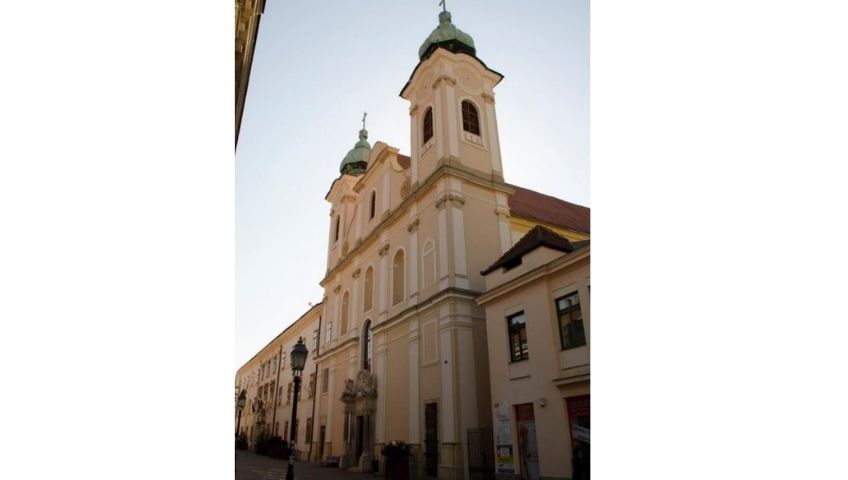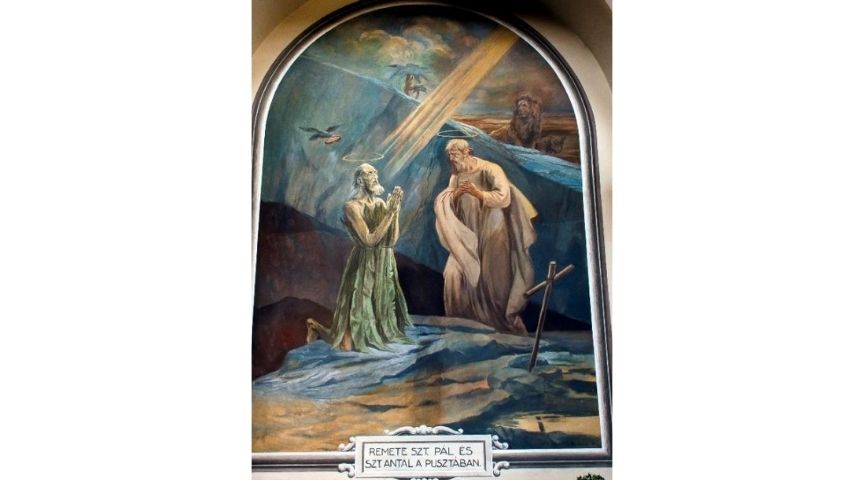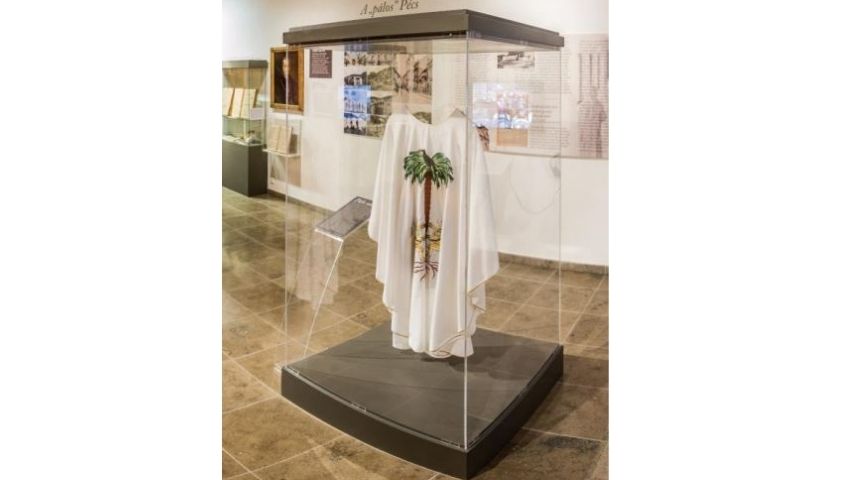The Pauline Order is the only existing monastic order that was founded by Hungarians.
The order was founded when Blessed Eusebius (Boldog Özséb), the canon of the cathedral of Esztergom resigned his dignities to live in seclusion in Pilis mountains. He is said to have been addressed in a vision to gather into a community other hermits scattered in the vicinity. In about 1250, he built a church and a monastery for his community near the village of Kesztölc. He chose Saint Paul, the first hermit, to be the patron saint of the order. A few years later other hermit communities joined the order, for example, the community headed by Bishop Bartholomew of Pécs who had had a monastery built for the local hermit community as early as 1225 on the mountain near Patacs, and he had written a short book of rules called the Rule for them to follow. In 1308 the Holy See gave permission to the order to use the Rule of St Augustine and gave the order important papal privileges.
The Pauline Order continued to thrive until the Turkish invasion. In the 15th century there were about 900 Pauline monks in Hungary, and the order had about 300 monasteries in 8 different provinces across the world. The monks were engaged in a wide range of spiritual and artistic activities. Some of their works such as the medieval prayer books called Festetics Code and Czech Code are important texts preserving Medieval Hungarian.
During the Turkish occupation they carried out missionary activities in places left without priests. Some of the outstanding figures include the great statesman George Martinuzzi cardinal and archbishop of Esztergom and the martyr György Csepelényi. After Buda was taken back from the Ottoman Empire in 1686, the Pauline Order throve again. The monks of the only Hungarian founded order made significant contributions to sciences and literature. The most notable poets were Ferenc Verseghy, Pál Ányos, and Benedek Virág who is considered the Hungarian Horatius and the “holy old man” by literary historians.
Despite the achievements of the order, Joseph II abolished the order that ceased its activities in Hungary for almost 150 years. Afterwards, the order could remain active in Poland. It was only in 1934 when they returned to Hungary. However, their activities were hampered again when the communist state banned monastic orders. At that time there were only 38 monks in Hungary who were persecuted by the dictatorial state. A martyr of this persecution was Pauline father Ferenc Vezér who was executed in 1951 as a result of the Grősz trial. Later trainee priests scattered across the country studied in seminaries and some of them joined the order illegally.
After the change of regime, the Pauline Order started over in four monasteries in Budapest, Pécs, Márianosztra, and Petőfiszállás. Some 25 years later, a new monastery was built in Hargitafürdő in Transylvania that was opened in January 2014. Marian Devotions centring around Mary, the Mother of God, are practiced by Paulines.
The current centre of the order is Jasna Góra Monastery, established by Hungarian Paulines in Częstochowa, Poland which is home to the Black Madonna painting – a shrine to the Virgin Mary. A sense of national unity has always been important to the order. Pauline monks pray and do penance for the nation and the homeland – not for themselves. Therefore, this motto is deeply rooted in the order: „Et tu Hungaria, mi dulcis patria, cum Paulinis crescis, et cum itidem decrescis.” (And you Hungary, my sweet fatherland, who with the Paulines grows, and with whom likewise fades.) In 2015 when Pope Francis proclaimed the Year of Consecrated Life, Pauline monks described their creed and mission as such:
“Our mission is rooted in our past when we were hermits: living in the presence of God, loving solitude, praying, a life of penance, and pious reverence for the Blessed Virgin Mary. As part of our apostolic mission, in response to changes, we also carry out pastoral activities, including preaching, the administration of sacraments, and most often, confession. As a Hungarian-founded monastic order, praying for and practicing atonement on behalf of our nation are an important part of our spirituality.”
Some more recent events reflect how the Hungarian Pauline Order is inextricably linked to the Hungarian nation and culture:
• In 2008, the Pauline Order received the Hungarian Heritage Award for their service over seven centuries.
• In 2012, János Áder, the President of Hungary awarded the Commander’s Cross with Star of the Hungarian Order of Merit to Pauline Father Roman Majewski, abbot of the monastery in Częstochowa for his activities to deepen the friendship between Hungary and Poland.
• In 2013, József Borsos, former chief of the Hungarian Pauline province, received the Grand Cross with Chain for his outstanding pastoral work among Hungarians living in Hungary and in Upper Hungary (now part of Slovakia) as well as for his activities to restart and strengthen the Pauline Order in Hungary after the change of regime.
• In the summer of 2017, the Pauline Order as a Hungarian founded monastic order was included in the Collection of Hungarikums by the Hungarikum Committee and received the title of Outstanding National Value for its spirituality and Hungarian cultural and historical heritage.
• In December 2017, The Pauline Order as the only Hungarian founded monastic order became a Hungarikum for the important role it has played in Hungarian culture, literature, history, and spiritual life for almost eight hundred years.
• On 15 March 2018, the President of Hungary awarded the Commander’s Cross with Star of the Hungarian Order of Merit to Pauline Father Marian Waligóra, abbot of the monastery in Częstochowa for his pastoral service among Hungarians living within and outside the border of Hungary, for his activities to deepen the friendship between Hungary and Poland, and for researching and preserving Hungarian cultural heritage in the Częstochowa monastery.



Paulines in Pécs
Paulines have been present in Pécs since about 1225 when Bishop Bartholomew of Pécs had a monastery built for the hermits living in Mecsek on Irugh (Ürög) mountain in the place of the old hillfort that was part of his estate in Patacs.
The bishop wrote the Rule of the order that regulated monastic life legally and ecclesiastically. When Blessed Eusebius started to gather into a community hermits scattered across the country, the hermits in Patacs were the first ones to join the hermits of the Holy Cross in Pilis. Thus, the hermit community in Pécs was the forerunner of the Pauline Order. In 1541 when the Turks started the siege of Pécs or in 1543 when they occupied the city, the Paulines were forced to flee their monastery in Jakab mountain. No sooner had the Turks been forced to leave, the Paulines returned to Pécs upon the bishop’s request.
Lyceum church
In 1686 Bishop Mátyás Radanay of Pécs invited four Pauline monks to Pécs to carry out pastoral service. They received an estate, near the former Buda Gate, with a church that had formerly been a Turkish mosque and then a Serbian church. They left the city in 1704 due to the frequent incursions of the Rascians but they returned in 1712. A new baroque style church was built between 1742 and 1756 followed by the construction of a new monastery between 1960 and 1775 to meet the needs of the growing congregation. The foundation stone was laid by Bishop Zsigmond Berényi in 1741 and the completed church was consecrated by Bishop György Klimó in 1756. Pauline monk Benedek Virág who was an outstanding poet of the Hungarian Enlightenment pursued his studies here. After the dissolution of the Order in 1786, the church and the monastery were out of use for half a century and all the equipment was taken away. In 1835, Bishop Ignác Szepessy purchased and renovated the buildings, and the faculty of law and humanities called Lyceum was relocated to the former Pauline monastery. This was the time when the citizens of Pécs started to call the church Lyceum. The building of the monastery is home to Széchenyi Grammar School now. Today, the church is owned by the Pauline Order again. The old, unused crypt can host 600 urns.
The Pauline (Saint Emeric) Church
After the Paulines had returned to Pécs in 1934, the Order decided to establish another monastery for the education of novices. The novitiate was built on the side of Mecsek Mountain and was opened on 25 October 1934, on the day of celebrating Saint Maurus, the co-patron saint of the diocese. Finishing their studies in the Novitiate, trainee priests of the Order studied theology in the seminary of the diocese.
In 1928, the city of Pécs invited applications for rearranging the city centre. The building of the Pauline Church was funded by the project and supported by the Pauline prior general and Bishop Ferenc Virág. The citizens of Pécs also made significant contributions to the construction project. Károly Weichinger, whose application was accepted, designed the church that was built in Hunyadi Street. Upon the request of the university students in Pécs, the church was named after the patron saint of the youth, Saint Emeric. The consecration of the church by Archbishop Gyula Zichy of Kalocsa on the day of Pentecost was attended by thousands of people.
In 1945, approaching the 700th anniversary of the Order, the idea, also supported by citizens, to build a small monastery and a small church near the ruins of the ancient monastery on Jakab Mountain was raised. The newspaper Új Ember (New Man) wrote about the village feast in Jakab Mountain on 27 July: “Four thousand people from Pécs and the neighbouring villages climbed the mountain. They carried bricks instead of rosaries… These bricks will be used in the walls of the monastery.” The construction works along with the operation of the Order were banned by the Communist government on 9 June 1950. Afterwards, priests took over the pastoral service of the monks in the Pauline church in Hunyadi Street. The director of the church, Gyula Kalász renovated the church between 1986 and 1987 and built residential areas called cells – an effort to facilitate the return of the Order after the change of regime. During the Communist rule, the church was used for midwife training. In the autumn of 1989, with the return of the Order, novice education was relaunched in Pécs again. Afterwards, Pauline trainee priests could continue their studies at the reopened Theological College of Pécs in the autumn of 1991.
Remarkable events of the past decade mark the cooperation between the Hungarian Pauline Order and Pécs. In 2008, the Conference on the History of the Pauline Order was held in Pécs that addressed the possibilities of discovering, preserving, and presenting Pauline architectural heritage. In April 2010, the Third Theatre of Pécs staged the educational and historical performance entitled ‘Asperges me… Paulines over the centuries in the light of Hungarian History’ starring Pál Oberfrank, Annamária Sudár and the Misztrál Band. The performance drew on the works of Pauline authors such as Pál Ányos, Adalbert Csanádi, Zsigmond Csúzy, Gergely Gyöngyösi, and Benedek Virág, as well as other documents, historical texts, and musical poems. The performance presented the major periods in the history of the Order and the most significant figures from Blessed Eusebius to contemporary figures.
From October 2014 to February 2015, the Modern Hungarian Gallery of Janus Pannonius Museum in Pécs hosted a large interactive exhibition called ‘Our Palines, the white monks’. The exhibition was jointly organised by the National Széchenyi Library and the Hungarian Pauline Order and was also sponsored by the city of Pécs. The multimedia exhibition on the history of the Pauline order, education, and culture marking the 80th anniversary of the return of Paulines and the 25th anniversary of restarting the Order in Hungary was concluded by a one-day conference on the history of the order held at the Faculty of Humanities of the University of Pécs. The conference proceedings entitled Our Paulines and Pécs was also published.
On 9 June 2018, Pécs hosted Congress VII of Pauline Settlements. The Congress held at a different Pauline city every year was relaunched by the Pauline Order and the mayors of Pauline settlements in 2010 to establish a tradition. The goals of the event are to preserve the shared history of the Pauline Order, to set mutual goals, and to deepen cooperation between the settlements. The Congress held in Pécs in 2018 marked a significant occasion, as Pécs was the first city that is also a county and bishopric seat where such an event was organised. Over 100 representatives from 27 Hungarian settlements attended the Congress. The Pauline Order in Pécs gave two bishops to the Diocese of Pécs: Pál Széchenyi V. (1676-1687) and Pál László Eszterházy (1787-1799). The centre of the Hungarian Pauline Order is in Pécs where the office of the Hungarian Province Chief is located. Paulines have been carrying out pastoral work in Pécs in the Pauline (Saint Emeric) Church since 1989 (when the Order was restarted) and in Lyceum Church since 1997. Among other things, their activities include presenting masses, performing confessions, administering sacraments, baptizing, performing weddings and funerals, and holding spiritual exercises.
In 1996, the Pauline Circle of Friends was established in the Pauline Church, with the aim of bringing together secular people who wanted to connect with Pauline spirituality. The goals of the Pauline Circle of Friends also include awakening vocations and involving believers on a larger scale in Pauline spirituality and in the every-day life of Pauline churches. The order being the only Hungarian-founded monastic order is closely linked to the culture of Hungarian Christianity; therefore, nurturing this connection is important for the Pálos Circle of Friends. This purpose is served by presentations at monthly meetings. The Pauline Church in Pécs and Lyceum Church are also home to several local Christian communities. These include the Gesztenyés community in Pécs holding a joint mass every Sunday in the Pauline Church; the Hungarian Kolping Association, the Marriage Encounter Movement, the Community of Sant’Egidio, the Legion of Mary, the Rosary Society, the Schola Sancti Pauli, the Lyceum Church Choir, acolyte communities, as well as several other communities and prayer groups holding their gatherings in one of the two Pauline churches. The Hungarian Pauline Order organises in Lyceum Church the Holy Mass marking the opening of the city festival which traditionally starts on 1 September. In 2013, the Pécs Committee for County Repository of Values added Jakab Hill and the former Pauline monastery to the municipal depository in the category of cultural heritage. On 1 September 2014, the Municipal Assembly of Pécs County Seat awarded the “Pro Communitate” commemorative medal to Father Botond Bátor in recognition of his community-building and pastoral service. On 1 September 2016, the Municipal Assembly of Pécs County Seat awarded the “Pro Communitate” award to the leaders of the Province of the Pauline Order in recognition of their community-building, pastoral, educational, humanitarian, and public service work.
